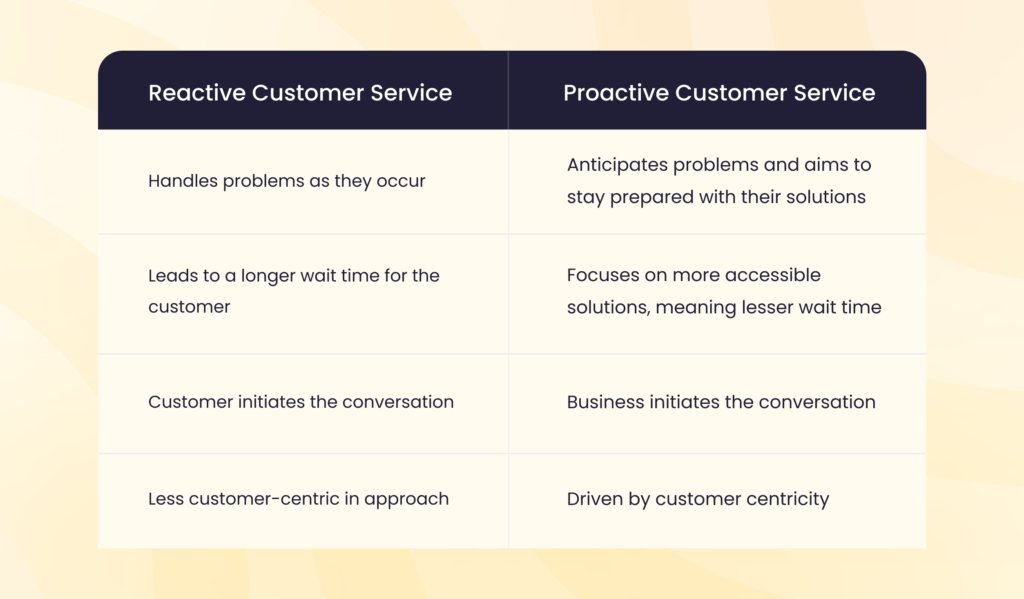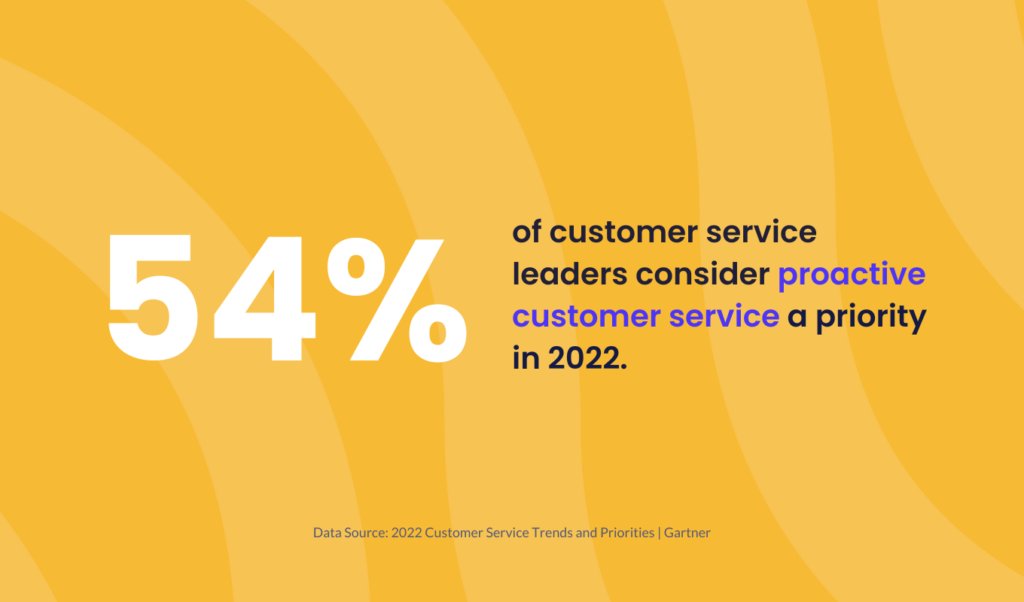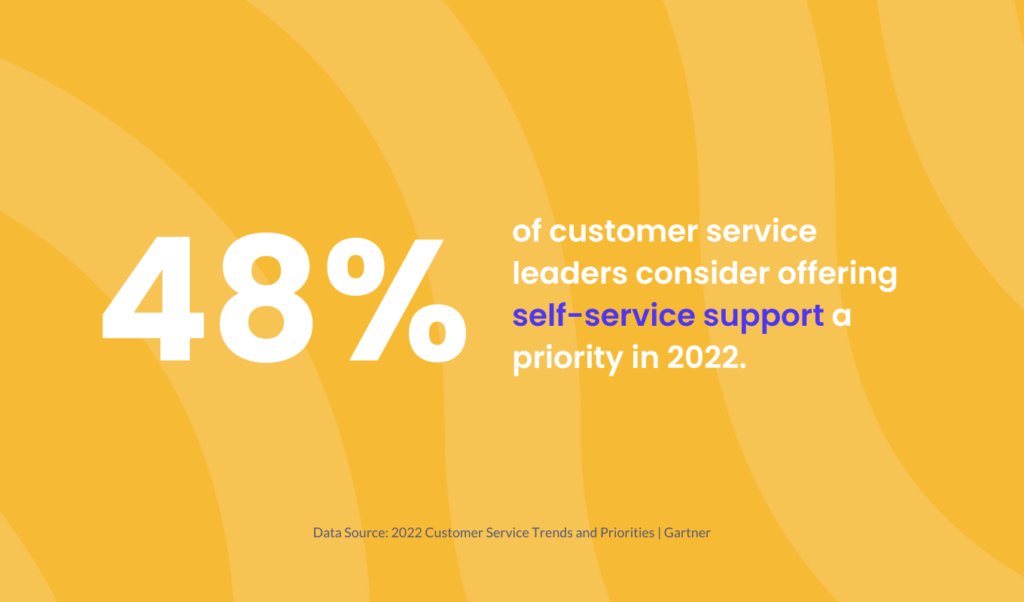Reactive to Proactive: How to Shift Your Support Strategy

Table of contents
Building good customer relationships is now more important than ever. It’s crucial for you and your support team to comprehend the pulse of your customers in this era of evolving customer preferences and hard-core competition. Not just by taking customer feedback but also by getting into their shoes and relating to your customers’ needs – the challenges they must be facing, answers they might be looking for, and expectations from your support team.
It’s easy – once you understand your customers in and out, half the job is done. The other half will then be about leading them to the right solution and getting that smile on their faces.
Don’t you want that too?
If you still rely on your customers to start the conversation and then react to it, you might want to switch lanes from reactive to proactive customer service.
Customers now expect companies to start the conversation. So much so that 87% of customers want to be proactively reached out to by a company for customer service-related issues (via MyCustomer).
Before we go ahead, let’s understand both Reactive and Proactive customer service better.
Table of Contents
- What’s What: Reactive V/S Proactive Customer Support
- Why is Proactive Customer Support the need of the hour?
- 5 ways to shift from Reactive to Proactive Customer Support
- Wrapping up
What’s What: Reactive V/S Proactive Customer Support
Reactive customer service waits for an error to occur and be reported before coming up with the solution. It’s passive, and honestly, just not enough in this hyper-competitive market.
Proactive customer service goes the extra mile. It’s smarter, better prepared, and much more customer-centric.

Why is Proactive Customer Support the need of the hour?
As customers, we all love proactive customer support.
We appreciate Amazon informing us in advance of any possible delays in delivery. It’s convenient when airlines call us to inform us about a schedule change before we leave for the airport.
Customers love convenience. So much so that 65% of US customers would pay more for excellent customer service (Emplifi).
Companies are now focusing on adopting a more customer-centric approach to customer service — anticipating customer pain points and smoothing the edges of the customer journey. According to a recent Gartner survey, shifting from reactive to proactive service is one of the primary objectives for more than half of the customer service and support leaders in 2022.

Customers prefer proactive customer support, and businesses profit heavily from a proactive approach; a clear win-win. Proactive customer service helps businesses reduce support calls and churns, build customer loyalty, and enhance their customer experience (CX) leading to higher customer retention rates. What’s not to like?
5 ways to shift from Reactive to Proactive Customer Support
If you also have customer satisfaction on your mind, here are 5 ways to shift from Reactive to Proactive Customer Support:
- Offer and update self-service options
- Give the mic to your customers
- Acknowledge your errors and correct them
- Create how-to tutorials
- Bridge the gap between you and your customers
1. Offer and Update Self-Service Options
It hardly comes as a shock that 35% of Americans find it important to have a fully self-serve customer care option available when they make a purchase (Emplifi).
Why is that? Well, it’s fast, easily accessible, and so much more convenient than having to dial up an agent. Having answers ready before the question pops is not only time effective for you but also an option your customers would love to have.
In 2022, more and more customer service and support leaders are focusing on making their self-service channels more effective.

From adding a FAQs section or a knowledge base to your website to customer support live chats are all ways to empower your customers to resolve their issues in real-time. In addition to these, you can also create product training videos, add escalation options to your chatbots, or even invest your resources into creating a comprehensive knowledge base for your customers.
One of the most common self-service options, the FAQs section is often underutilized. While most businesses do take the proactive step to have a FAQs section but don’t do a great job when it comes to updating it — making it feel like an afterthought.
When multiple customers come to you with a similar challenge, it’s safe to say that others might also need a copy of the solution soon. A great step to level up your customer experience is to ask your support team to share insights from their recent customer conversations.
Clearly, the only way to resolve these customer issues and create a loyal customer base is by initiating the conversation proactively. You can start with a simple step — asking them. Put together customer satisfaction and feedback surveys that can give you an overview of how they feel about your product.
To gather this information, you can run a short survey or just an open discussion within your customer service team that’s well documented. But before you start, know what answers you need from this exercise.
You might want to know:
- What are some new queries that they are regularly facing?
- Is a new feature too complex to use for customers?
- Is there an integration service that frequently requires support from an agent?
Don’t miss the step of adding fresh insights and questions to your FAQ section. This will not only expand and refresh the section but also help you underline what you can do better with your product. Your customers will thank you for it.
2. Give the Mic to Your Customers
Esteban Kolsky, CEO of ThinkJar and former Gartner analyst, conducted a customer experience survey, revealing only 1 in 26 unhappy customers voice their concerns. What about the other 25? They churn.
Don’t confuse this with a lengthy set of questions that are extremely specific and tedious to answer. This leads to receiving much less feedback and missing out on valuable input, even after you invest your time and resources to create one.
Try asking questions that are easy to answer, but also get you the information you need, like:
“Are there any recurrent issues you run into?”
“Are there any features you’d like us to offer?”
If your customer feedback survey includes subjective questions, balance it with questions that are more digestible and less time-consuming. Consider adding questions that can be answered with only a click, like:
“On a scale of 1 to 10..”
“Choose out of the following..”
Customer experience surveys provide you with crucial metrics that can aid your efforts to offer exceptional customer service. A common blunder with feedback surveys is that they often remain a one-off initiative and go underutilized, despite being a great opportunity to offer proactive customer service.
3. Acknowledge Your Errors and Correct Them
To err is human, and your customers understand that, as long as you fix them and remain transparent.
There will be inevitable times when your product or service isn’t at its peak performance. It could be a delay in delivery or a bug in your product that is still getting fixed. Sending out an apology email, posting on your social media handles, or acknowledging the problem on your website can let the customers know that it’s being worked on before they have to reach out and complain. Add details to keep your customers well informed, such as:
- An estimated time by when you will resolve the issue
- Information on refund/credits against the delay if any
- How to reach you in case they have more queries
A great example of proactive customer service is how Netflix deals with technical streaming issues. When Netflix servers go down, it can leave its customer base of over 200 million displeased. To ensure they provide proactive customer support, Netflix releases an official statement on its social media handles acknowledging the issue and provides credits to its users to compensate for the streaming time lost.
4. Create How-to Tutorials
We all have tech gurus on Youtube to thank for their detailed, step-by-step tutorials that solve our everyday tech problems. Help your customers save time with how-to videos to assist them better.
A Forrester survey reveals that 53% of customers will not make an online purchase if they find the answer to their question too hard to understand. Video tutorials are a great way to guide your customers to the solution at their own pace and leisure, even when they’re a little complex.
To get started, shortlist questions from your FAQs repository which involve multiple steps or ones that your customer service team frequently encounters. You can then add the how-to tutorials to your website and also create a playlist on your business’s social media handles to make it more accessible to your customers.
5. Bridge the Gap between You and Your Customers
Proactive customer service is not just your customer support team’s responsibility; it’s an organization-wide commitment Your non-customer-facing teams have much to learn from and offer to your customer interactions.
According to Hiver’s customer support survey report, 66% of customers think a company’s customer service is critical when making a purchase. Outdated customer service tools and help desks can seriously hinder internal collaborations, missing opportunities to offer seamless and proactive customer support.
Here’s where multi-channel customer service solutions like Hiver can come to the rescue. While working on top of Gmail’s native interface to maintain familiarity, it can help you collaborate with your teammates, create dashboards, get customer feedback, and much more.
Wrapping up
Do as you’d be done by — that’s what proactive customer service is all about.
Offering proactive service gives you more than just happy customers; it gives you brand advocates and opens doors to gaining new customers and expanding your business.
As long as you’re putting yourself in your customers’ shoes, choosing the right customer service software, and constantly improving your customer journey, you’re heading in the right direction.

































